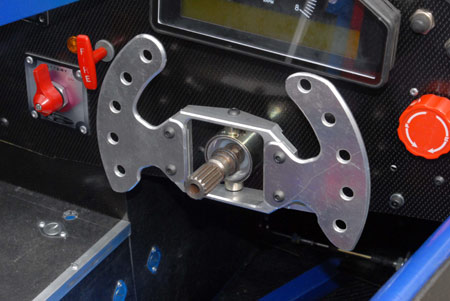The Downshift
One of the skills of a race driver, indeed any driver, years ago was that of changing gear. Being able to change gear quickly and accurately, taking into account the vehicle speed and the ratio being selected, and doing so time after time without any unruly noise or damage to the gears/dog rings was a skill to be proud of - and not only prevented damage to the gearbox but won races too. Indeed, engineers who regularly stripped and maintained the gearboxes of the great but only two-times Formula One World Champion Jim Clark would claim that they could always tell his gearbox because of the lack of any wear on the dog clutches, such was his mechanical prowess.
These days of course, many gearboxes have barrel gear selector mechanisms and electronic control such that changing up in the gearbox no longer requires hand-to-foot coordination, and the simple flick of a paddle moves to the next gear with only a momentary cut of the ignition and hence forward progress. Systems exist that reduce this ignition cut time to as little as 20 ms, and while some may claim it is ’seamless’ as far as the driver is concerned, with the overall lap time saved counted in some cases in many seconds, technically I might take issue. During all this the clutch remains untouched, and the driving force between the gear teeth is momentarily reduced by the action of the ignition cut.
The real test of gearbox control, however, must surely be in the downshift. Since the driver is slowing the vehicle on the brakes there is less of an inherent advantage in terms of lap time saved, but in synchronising the input and output shafts as we move down the box, just like the practice of ‘heel and toeing’ in years past, if it’s done correctly it can spare the gearbox much abuse and hence stand a greater chance of lasting the race.
Considering the use of motorcycle engines and gearboxes into hill climb or track day cars, during a braking event when the driver wants to change down, even in the simplest of systems the gearbox control unit (GCU) will first check to ensure that first gear is not already selected. If this is the case, the down change will be aborted and will prevent the driver from selecting neutral in a typical motorcycle gearbox when downshifting at slow speeds.
Following a demand from the gear change paddle to change down, the clutch will be powered open. Once open, the gear actuator will be powered and a short delay introduced as the next gear is selected. At this point, and depending on the gear selected, the throttle or throttles will be opened again using what is generally known as a ‘throttle blipper’. This revs the engine to synchronise the road speed to the engine speed before powering the clutch closed again to complete the gear change.
Using sensors to determine the relative shaft speeds, gear changes can be aborted if the engine is likely to be over-revved, but above all by taking care of the complete gear-change process the driver is left with two hands on the wheel and can concentrate more on the braking of the vehicle and the correct line through the corner. Many aftermarket systems can use pneumatic actuators because of their forgiving nature, but more often solenoid-operated systems can be more sympathetic to the forces needed and better controlled by the electronic GCU.
Systems of this nature may not be of the complexity of the real seamless shift variety, but for thousands of racers using motorcycle-based engine-gearbox combinations the results can be highly satisfying.
But not as much as I would think of the perfect ‘heel and toe’.

Fig. 1 - Typical gear change paddle
Written by John Coxon